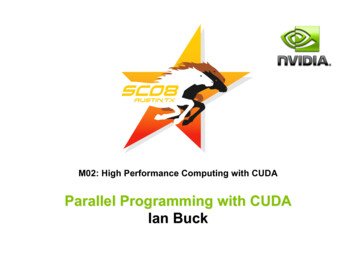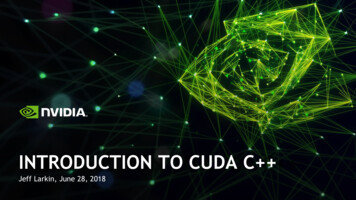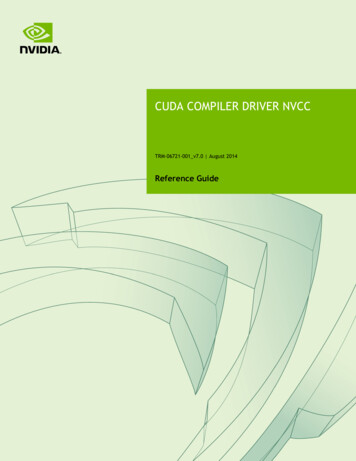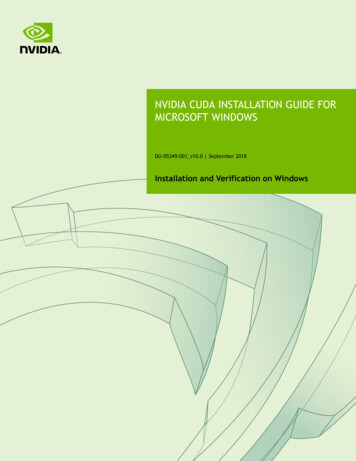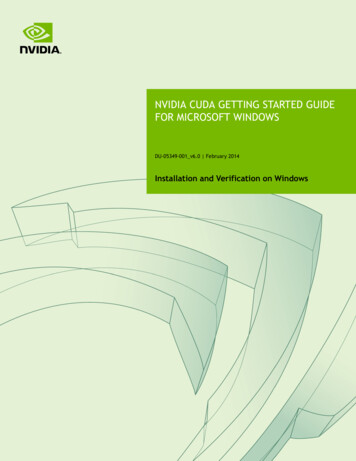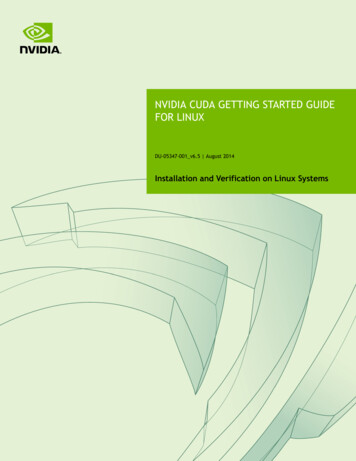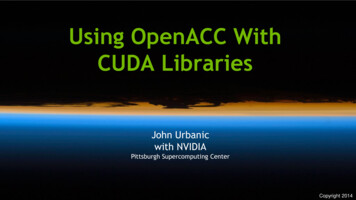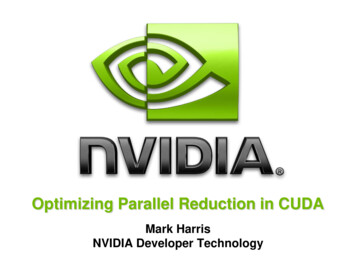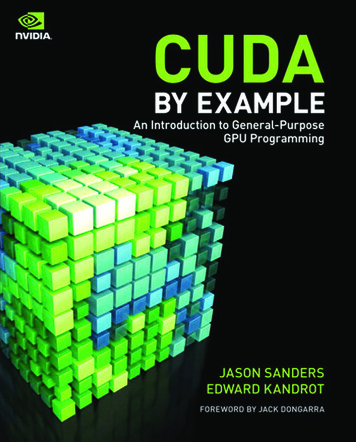
Transcription
CUDA by Example
This page intentionally left blank
CUDA by ExamplegJAson sAndersedwArd KAndrotUpper Saddle River, NJ Boston Indianapolis San FranciscoNew York Toronto Montreal London Munich Paris MadridCapetown Sydney Tokyo Singapore Mexico City
Many of the designations used by manufacturers and sellers to distinguish their products areclaimed as trademarks. Where those designations appear in this book, and the publisher wasaware of a trademark claim, the designations have been printed with initial capital letters or in allcapitals.The authors and publisher have taken care in the preparation of this book, but make no expressedor implied warranty of any kind and assume no responsibility for errors or omissions. No liability isassumed for incidental or consequential damages in connection with or arising out of the use of theinformation or programs contained herein.NVIDIA makes no warranty or representation that the techniques described herein are free fromany Intellectual Property claims. The reader assumes all risk of any such claims based on his orher use of these techniques.The publisher offers excellent discounts on this book when ordered in quantity for bulk purchasesor special sales, which may include electronic versions and/or custom covers and contentparticular to your business, training goals, marketing focus, and branding interests. For moreinformation, please contact:U.S. Corporate and Government Sales(800) 382-3419corpsales@pearsontechgroup.comFor sales outside the United States, please contact:International Salesinternational@pearson.comVisit us on the Web: informit.com/awLibrary of Congress Cataloging-in-Publication DataSanders, Jason.CUDA by example : an introduction to general-purpose GPU programming /Jason Sanders, Edward Kandrot.p. cm.Includes index.ISBN 978-0-13-138768-3 (pbk. : alk. paper)1. Application software—Development. 2. Computer architecture. 3.Parallel programming (Computer science) I. Kandrot, Edward. II. Title.QA76.76.A65S255 2010005.2'75—dc222010017618Copyright 2011 NVIDIA CorporationAll rights reserved. Printed in the United States of America. This publication is protected by copyright, and permission must be obtained from the publisher prior to any prohibited reproduction,storage in a retrieval system, or transmission in any form or by any means, electronic, mechanical,photocopying, recording, or likewise. For information regarding permissions, write to:Pearson Education, Inc.Rights and Contracts Department501 Boylston Street, Suite 900Boston, MA 02116Fax: (617) 671-3447ISBN-13: 978-0-13-138768-3ISBN-10:0-13-138768-5Text printed in the United States on recycled paper at Edwards Brothers in Ann Arbor, Michigan.First printing, July 2010
To our families and friends, who gave us endless support.To our readers, who will bring us the future.And to the teachers who taught our readers to read.
This page intentionally left blank
ContentsForeword . . . . . . . . . . . . . . . . . . . . . . . . . . . . . . . . . . . . xiiiPreface . . . . . . . . . . . . . . . . . . . . . . . . . . . . . . . . . . . . . xvAcknowledgments . . . . . . . . . . . . . . . . . . . . . . . . . . . . . . xviiAbout the Authors . . . . . . . . . . . . . . . . . . . . . . . . . . . . . . . xix1Why CUDA? Why NoW?11.1 Chapter Objectives . . . . . . . . . . . . . . . . . . . . . . . . . . . . . . 21.2 The Age of Parallel Processing . . . . . . . . . . . . . . . . . . . . . . . 21.2.1 Central Processing Units . . . . . . . . . . . . . . . . . . . . . . . . 21.3 The Rise of GPU Computing . . . . . . . . . . . . . . . . . . . . . . . . . 41.3.1 A Brief History of GPUs . . . . . . . . . . . . . . . . . . . . . . . . . 41.3.2 Early GPU Computing . . . . . . . . . . . . . . . . . . . . . . . . . . 51.4 CUDA . . . . . . . . . . . . . . . . . . . . . . . . . . . . . . . . . . . . . 61.4.1 What Is the CUDA Architecture? . . . . . . . . . . . . . . . . . . . . 71.4.2 Using the CUDA Architecture . . . . . . . . . . . . . . . . . . . . . . 71.5 Applications of CUDA . . . . . . . . . . . . . . . . . . . . . . . . . . . . 81.5.1 Medical Imaging . . . . . . . . . . . . . . . . . . . . . . . . . . . . . 81.5.2 Computational Fluid Dynamics. . . . . . . . . . . . . . . . . . . .91.5.3 Environmental Science . . . . . . . . . . . . . . . . . . . . . . . . 101.6 Chapter Review . . . . . . . . . . . . . . . . . . . . . . . . . . . . . . . 11vii
contents1321374.1 Chapter Objectives . . . . . . . . . . . . . . . . . . . . . . . . . . . . . 384.2 CUDA Parallel Programming . . . . . . . . . . . . . . . . . . . . . . . 384.2.1 Summing Vectors . . . . . . . . . . . . . . . . . . . . . . . . . . . . 384.2.2 A Fun Example . . . . . . . . . . . . . . . . . . . . . . . . . . . . . 464.3 Chapter Review . . . . . . . . . . . . . . . . . . . . . . . . . . . . . . . 57viii
contents59951157.1 Chapter Objectives . . . . . . . . . . . . . . . . . . . . . . . . . . . . 1167.2 Texture Memory Overview . . . . . . . . . . . . . . . . . . . . . . . . 116ix
Contents1391639.1 Chapter objectives . . . . . . . . . . . . . . . . . . . . . . . . . . . . 1649.2 Compute Capability . . . . . . . . . . . . . . . . . . . . . . . . . . . 1649.2.1 the Compute Capability of nVIDIA GPUs . . . . . . . . . . . . . 1649.2.2 Compiling for a Minimum Compute Capability . . . . . . . . . . 1679.3 Atomic operations overview . . . . . . . . . . . . . . . . . . . . . . 1689.4 Computing Histograms . . . . . . . . . . . . . . . . . . . . . . . . . 1709.4.1 CPU Histogram Computation . . . . . . . . . . . . . . . . . . . . 1719.4.2 GPU Histogram Computation . . . . . . . . . . . . . . . . . . . . 1739.5 Chapter Review . . . . . . . . . . . . . . . . . . . . . . . . . . . . . . 183x
contents18521323712.1 Chapter Objectives . . . . . . . . . . . . . . . . . . . . . . . . . . . . 23812.2 CUDA Tools . . . . . . . . . . . . . . . . . . . . . . . . . . . . . . . . 23812.2.1 CUDA Toolkit . . . . . . . . . . . . . . . . . . . . . . . . . . . . 23812.2.2 CUFFT . . . . . . . . . . . . . . . . . . . . . . . . . . . . . . . . 23912.2.3 CUBLAS . . . . . . . . . . . . . . . . . . . . . . . . . . . . . . . 23912.2.4 NVIDIA GPU Computing SDK . . . . . . . . . . . . . . . . . . . 240xi
Contents249A.1 Dot Product Revisited . . . . . . . . . . . . . . . . . . . . . . . . . . 250A.1.1Atomic Locks . . . . . . . . . . . . . . . . . . . . . . . . . . . . 251A.1.2Dot Product Redux: Atomic Locks . . . . . . . . . . . . . . . . 254A.2 Implementing a Hash table . . . . . . . . . . . . . . . . . . . . . . . 258A.2.1Hash table overview . . . . . . . . . . . . . . . . . . . . . . . . 259A.2.2 A CPU Hash table . . . . . . . . . . . . . . . . . . . . . . . . . . 261A.2.3 Multithreaded Hash table . . . . . . . . . . . . . . . . . . . . . 267A.2.4 A GPU Hash table . . . . . . . . . . . . . . . . . . . . . . . . . . 268A.2.5 Hash table Performance. . . . . . . . . . . . . . . . . . . . . 276A.3 Appendix Review . . . . . . . . . . . . . . . . . . . . . . . . . . . . . 277Index . . . . . . . . . . . . . . . . . . . . . . . . . . . . . . . . . . . . . 279xii
ForewordRecent activities of major chip manufacturers such as NVIDIA make it moreevident than ever that future designs of microprocessors and large HPCsystems will be hybrid/heterogeneous in nature. These heterogeneous systemswill rely on the integration of two major types of components in varyingproportions: multi- and many-core CPU technology: The number of cores will continue toescalate because of the desire to pack more and more components on a chipwhile avoiding the power wall, the instruction-level parallelism wall, and thememory wall. Special-purpose hardware and massively parallel accelerators: For example,GPUs from NVIDIA have outpaced standard CPUs in floating-point performancein recent years. Furthermore, they have arguably become as easy, if not easier,to program than multicore CPUs.The relative balance between these component types in future designs is notclear and will likely vary over time. There seems to be no doubt that futuregenerations of computer systems, ranging from laptops to supercomputers,will consist of a composition of heterogeneous components. Indeed, the petaflop(1015 floating-point operations per second) performance barrier was breached bysuch a system.And yet the problems and the challenges for developers in the new computationallandscape of hybrid processors remain daunting. Critical parts of the softwareinfrastructure are already having a very difficult time keeping up with the paceof change. In some cases, performance cannot scale with the number of coresbecause an increasingly large portion of time is spent on data movement ratherthan arithmetic. In other cases, software tuned for performance is delivered yearsafter the hardware arrives and so is obsolete on delivery. And in some cases, ason some recent GPUs, software will not run at all because programming environments have changed too much.xiii
orewordCUDA by Example addresses the heart of the software development challenge byleveraging one of the most innovative and powerful solutions to the problem ofprogramming the massively parallel accelerators in recent years.This book introduces you to programming in CUDA C by providing examples andinsight into the process of constructing and effectively using NVIDIA GPUs. Itpresents introductory concepts of parallel computing from simple examples todebugging (both logical and performance), as well as covers advanced topics andissues related to using and building many applications. Throughout the book,programming examples reinforce the concepts that have been presented.The book is required reading for anyone working with accelerator-basedcomputing systems. It explores parallel computing in depth and provides anapproach to many problems that may be encountered. It is especially useful forapplication developers, numerical library writers, and students and teachers ofparallel computing.I have enjoyed and learned from this book, and I feel confident that you willas well.Jack DongarraUniversity Distinguished Professor, University of Tennessee Distinguished ResearchStaff Member, Oak Ridge National Laboratoryxiv
PrefaceThis book shows how, by harnessing the power of your computer’s graphicsprocess unit (GPU), you can write high-performance software for a wide rangeof applications. Although originally designed to render computer graphics ona monitor (and still used for this purpose), GPUs are increasingly being calledupon for equally demanding programs in science, engineering, and finance,among other domains. We refer collectively to GPU programs that addressproblems in nongraphics domains as general-purpose. Happily, although youneed to have some experience working in C or C to benefit from this book,you need not have any knowledge of computer graphics. None whatsoever! GPUprogramming simply offers you an opportunity to build—and to build mightily—on your existing programming skills.To program NVIDIA GPUs to perform general-purpose computing tasks, youwill want to know what CUDA is. NVIDIA GPUs are built on what’s known asthe CUDA Architecture. You can think of the CUDA Architecture as the schemeby which NVIDIA has built GPUs that can perform both traditional graphicsrendering tasks and general-purpose tasks. To program CUDA GPUs, we willbe using a language known as CUDA C. As you will see very early in this book,CUDA C is essentially C with a handful of extensions to allow programming ofmassively parallel machines like NVIDIA GPUs.We’ve geared CUDA by Example toward experienced C or C programmerswho have enough familiarity with C such that they are comfortable reading andwriting code in C. This book builds on your experience with C and intends to serveas an example-driven, “quick-start” guide to using NVIDIA’s CUDA C programming language. By no means do you need to have done large-scale softwarearchitecture, to have written a C compiler or an operating system kernel, or toknow all the ins and outs of the ANSI C standards. However, we do not spendtime reviewing C syntax or common C library routines such as malloc() ormemcpy(), so we will assume that you are already reasonably familiar with thesetopics.xv
refaceYou will encounter some techniques that can be considered general parallelprogramming paradigms, although this book does not aim to teach generalparallel programming techniques. Also, while we will look at nearly every part ofthe CUDA API, this book does not serve as an extensive API reference nor will itgo into gory detail about every tool that you can use to help develop your CUDA Csoftware. Consequently, we highly recommend that this book be used in conjunction with NVIDIA’s freely available documentation, in particular the NVIDIA CUDAProgramming Guide and the NVIDIA CUDA Best Practices Guide. But don’t stressout about collecting all these documents because we’ll walk you through everything you need to do.Without further ado, the world of programming NVIDIA GPUs with CUDA C awaits!xvi
AcknowledgmentsIt’s been said that it takes a village to write a technical book, and CUDA by Exampleis no exception to this adage. The authors owe debts of gratitude to many people,some of whom we would like to thank here.Ian Buck, NVIDIA’s senior director of GPU computing software, has been immeasurably helpful in every stage of the development of this book, from championingthe idea to managing many of the details. We also owe Tim Murray, our alwayssmiling reviewer, much of the credit for this book possessing even a modicum oftechnical accuracy and readability. Many thanks also go to our designer, DarwinTat, who created fantastic cover art and figures on an extremely tight schedule.Finally, we are much obliged to John Park, who helped guide this project throughthe delicate legal process required of published work.Without help from Addison-Wesley’s staff, this book would still be nothing morethan a twinkle in the eyes of the authors. Peter Gordon, Kim Boedigheimer, andJulie Nahil have all shown unbounded patience and professionalism and havegenuinely made the publication of this book a painless process. Additionally,Molly Sharp’s production work and Kim Wimpsett’s copyediting have utterlytransformed this text from a pile of documents riddled with errors to the volumeyou’re reading today.Some of the content of this book could not have been included without thehelp of other contributors. Specifically, Nadeem Mohammad was instrumentalin researching the CUDA case studies we present in Chapter 1, and NathanWhitehead generously provided code that we incorporated into examplesthroughout the book.We would be remiss if we didn’t thank the others who read early drafts ofthis text and provided helpful feedback, including Genevieve Breed and KurtWall. Many of the NVIDIA software engineers provided invaluable technicalxvii
AcKnowledGmentsassistance during the course of developing the content for CUDA by Example,including Mark Hairgrove who scoured the book, uncovering all manner ofinconsistencies—technical, typographical, and grammatical. Steve Hines,Nicholas Wilt, and Stephen Jones consulted on specific sections of the CUDAAPI, helping elucidate nuances that the authors would have otherwise overlooked. Thanks also go out to Randima Fernando who helped to get this projectoff the ground and to Michael Schidlowsky for acknowledging Jason in his book.And what acknowledgments section would be complete without a heartfeltexpression of gratitude to parents and siblings? It is here that we would like tothank our families, who have been with us through everything and have madethis all possible. With that said, we would like to extend special thanks to lovingparents, Edward and Kathleen Kandrot and Stephen and Helen Sanders. Thanksalso go to our brothers, Kenneth Kandrot and Corey Sanders. Thank you all foryour unwavering support.xviii
About the AuthorsJason Sanders is a senior software engineer in the CUDA Platform group atNVIDIA. While at NVIDIA, he helped develop early releases of CUDA systemsoftware and contributed to the OpenCL 1.0 Specification, an industry standardfor heterogeneous computing. Jason received his master’s degree in computerscience from the University of California Berkeley where he published research inGPU computing, and he holds a bachelor’s degree in electrical engineering fromPrinceton University. Prior to joining NVIDIA, he previously held positions at ATITechnologies, Apple, and Novell. When he’s not writing books, Jason is typicallyworking out, playing soccer, or shooting photos.edward Kandrot is a senior software engineer on the CUDA Algorithms team atNVIDIA. He has more than 20 years of industry experience focused on optimizingcode and improving performance, including for Photoshop and Mozilla. Kandrothas worked for Adobe, Microsoft, and Google, and he has been a consultant atmany companies, including Apple and Autodesk. When not coding, he can befound playing World of Warcraft or visiting Las Vegas for the amazing food.xix
This page intentionally left blank
Chapter 1Why CUDA? Why Now?There was a time in the not-so-distant past when parallel computing was lookedupon as an “exotic” pursuit and typically got compartmentalized as a specialtywithin the field of computer science. This perception has changed in profoundways in recent years. The computing world has shifted to the point where, farfrom being an esoteric pursuit, nearly every aspiring programmer needs trainingin parallel programming to be fully effective in computer science. Perhaps you’vepicked this book up unconvinced about the importance of parallel programmingin the computing world today and the increasingly large role it will play in theyears to come. This introductory chapter will examine recent trends in the hardware that does the heavy lifting for the software that we as programmers write.In doing so, we hope to convince you that the parallel computing revolution hasalready happened and that, by learning CUDA C, you’ll be well positioned to writehigh-performance applications for heterogeneous platforms that contain bothcentral and graphics processing units.1
WHY CUDA? WHY NOW?Chapter ObjectivesThe Age of Parallel ProcessingIn recent years, much has been made of the computing industry’s widespreadshift to parallel computing. Nearly all consumer computers in the year 2010will ship with multicore central processors. From the introduction of dual-core,low-end netbook machines to 8- and 16-core workstation computers, no longerwill parallel computing be relegated to exotic supercomputers or mainframes.Moreover, electronic devices such as mobile phones and portable music playershave begun to incorporate parallel computing capabilities in an effort to providefunctionality well beyond those of their predecessors.More and more, software developers will need to cope with a variety of parallelcomputing platforms and technologies in order to provide novel and rich experiences for an increasingly sophisticated base of users. Command prompts are out;multithreaded graphical interfaces are in. Cellular phones that only make callsare out; phones that can simultaneously play music, browse the Web, and provideGPS services are in.1.2.1 centrAl ProcessInG unItsFor 30 years, one of the important methods for the improving the performanceof consumer computing devices has been to increase the speed at which theprocessor’s clock operated. Starting with the first personal computers of the early1980s, consumer central processing units (CPUs) ran with internal clocks operating around 1MHz. About 30 years later, most desktop processors have clockspeeds between 1GHz and 4GHz, nearly 1,000 times faster than the clock on the2
rocessingoriginal personal computer. Although increasing the CPU clock speed is certainlynot the only method by which computing performance has been improved, it hasalways been a reliable source for improved performance.In recent years, however, manufacturers have been forced to look for alternatives to this traditional source of increased computational power. Because ofvarious fundamental limitations in the fabrication of integrated circuits, it is nolonger feasible to rely on upward-spiraling processor clock speeds as a meansfor extracting additional power from existing architectures. Because of power andheat restrictions as well as a rapidly approaching physical limit to transistor size,researchers and manufacturers have begun to look elsewhere.Outside the world of consumer computing, supercomputers have for decadesextracted massive performance gains in similar ways. The performance of aprocessor used in a supercomputer has climbed astronomically, similar to theimprovements in the personal computer CPU. However, in addition to dramaticimprovements in the performance of a single processor, supercomputer manufacturers have also extracted massive leaps in performance by steadily increasingthe number of processors. It is not uncommon for the fastest supercomputers tohave tens or hundreds of thousands of processor cores working in tandem.In the search for additional processing power for personal computers, theimprovement in supercomputers raises a very good question: Rather than solelylooking to increase the performance of a single processing core, why not putmore than one in a personal computer? In this way, personal computers couldcontinue to improve in performance without the need for continuing increases inprocessor clock speed.In 2005, faced with an increasingly competitive marketplace and few alternatives,leading CPU manufacturers began offering processors with two computing coresinstead of one. Over the following years, they followed this development with therelease of three-, four-, six-, and eight-core central processor units. Sometimesreferred to as the multicore revolution, this trend has marked a huge shift in theevolution of the consumer computing market.Today, it is relatively challenging to purchase a desktop computer with a CPUcontaining but a single computing core. Even low-end, low-power central processors ship with two or more cores per die. Leading CPU manufacturers havealready announced plans for 12- and 16-core CPUs, further confirming thatparallel computing has arrived for good.3
WHY CUDA? WHY NOW?The Rise of GPU ComputingIn comparison to the central processor’s traditional data processing pipeline,performing general-purpose computations on a graphics processing unit (GPU) isa new concept. In fact, the GPU itself is relatively new compared to the computingfield at large. However, the idea of computing on graphics processors is not asnew as you might believe.1.3.1 A BRIEF HISTORY OF GPUSWe have already looked at how central processors evolved in both clock speedsand core count. In the meantime, the state of graphics processing underwent adramatic revolution. In the late 1980s and early 1990s, the growth in popularity ofgraphically driven operating systems such as Microsoft Windows helped createa market for a new type of processor. In the early 1990s, users began purchasing2D display accelerators for their personal computers. These display acceleratorsoffered hardware-assisted bitmap operations to assist in the display and usabilityof graphical operating systems.Around the same time, in the world of professional computing, a company bythe name of Silicon Graphics spent the 1980s popularizing the use of threedimensional graphics in a variety of markets, including government and defenseapplications and scientific and technical visualization, as well as providing thetools to create stunning cinematic effects. In 1992, Silicon Graphics opened theprogramming interface to its hardware by releasing the OpenGL library. SiliconGraphics intended OpenGL to be used as a standardized, platform-independentmethod for writing 3D graphics applications. As with parallel processing andCPUs, it would only be a matter of time before the technologies found their wayinto consumer applications.By the mid-1990s, the demand for consumer applications employing 3D graphicshad escalated rapidly, setting the stage for two fairly significant developments.First, the release of immersive, first-person games such as Doom, Duke Nukem3D, and Quake helped ignite a quest to create progressively more realistic 3D environments for PC gaming. Although 3D graphics would eventually work their wayinto nearly all computer games, the popularity of the nascent first-person shootergenre would significantly accelerate the adoption of 3D graphics in consumercomputing. At the same time, companies such as NVIDIA, ATI Technologies,and 3dfx Interactive began releasing graphics accelerators that were affordable4
omputingenough to attract widespread attention. These developments cemented 3Dgraphics as a technology that would figure prominently for years to come.The release of NVIDIA’s GeForce 256 further pushed the capabilities of consumergraphics hardware. For the first time, transform and lighting computations couldbe performed directly on the graphics processor, thereby enhancing the potentialfor even more visually interesting applications. Since transform and lighting werealready integral parts of the OpenGL graphics pipeline, the GeForce 256 markedthe beginning of a natural progression where increasingly more of the graphicspipeline would be implemented directly on the graphics processor.From a parallel-computing standpoint, NVIDIA’s release of the GeForce 3 seriesin 2001 represents arguably the most important breakthrough in GPU technology.The GeForce 3 series was the computing industry’s first chip to implementMicrosoft’s then-new DirectX 8.0 standard. This standard required that complianthardware contain both programmable vertex and programmable pixel shadingstages. For the first time, developers had some control over the exact computations that would be performed on their GPUs.1.3.2 eArly GPu comPutInGThe release of GPUs that possessed programmable pipelines attracted manyresearchers to the possibility of using graphics hardware for more than simplyOpenGL- or DirectX-based rendering. The general approach in the early days ofGPU computing was extraordinarily convoluted. Because standard graphics APIssuch as OpenGL and DirectX were still the only way to interact with a GPU, anyattempt to perform arbitrary computations on a GPU would still be subject to theconstraints of programming within a graphics API. Because of this, researchersexplored general-purpose computation through graphics APIs by trying to maketheir problems appear to the GPU to be traditional rendering.Essentially, the GPUs of the early 2000s were designed to produce a color forevery pixel on the screen using programmable arithmetic units known as pixelshaders. In general, a pixel shader uses its (x,y) position on the screen as wellas some additional information to combine various inputs in computing a finalcolor. The additional information could be input colors, texture coordinates, orother attributes that would be passed to the shader when it ran. But becausethe arithmetic being performed on the input colors and textures was completelycontrolled by the programmer, researchers observed that these input “colors”could actually be any data.5
WHY CUDA? WHY NOW?So if the inputs were actually numerical data signifying something other thancolor, programmers could then program the pixel shaders to perform arbitrarycomputations on this data. The results would be handed back to the GPU as thefinal pixel “color,” although the colors would simply be the result of whatevercomputations the programmer had instructed the GPU to perform on their inputs.This data could be read back by the researchers, and the GPU would never be thewiser. In essence, the GPU was being tricked into performing nonrendering tasksby making those tasks appear as if they were a standard rendering. This trickerywas very clever but also very convoluted.Because of the high arithmetic throughput of GPUs, initial results from theseexperiments promised a bright future for GPU computing. However, the programming model was still far too restrictive for any critical mass of developers toform. There were tight resource constraints, since programs could receive inputdata only from a handful of input colors and a handful of texture units. Therewere serious limitations on how and where the programmer could write resultsto memory, so algorithms requiring the ability to write to arbitrary locations inmemory (scatter) could not run on a GPU. Moreover, it was nearly impossible topredict how your particular GPU would deal with floating-point data, if it handledfloating-point data at all, so most scientific computations would be unable touse a GPU. Finally, when the program inevitably computed the incorrect results,failed to terminate, or simply hung the machine, there existed no reasonably goodmethod to debug any code that was being executed on the GPU.As if the limitations weren’t severe enough, anyone who still wanted to use a GPUto perform general-purpose computations would need to learn OpenGL or DirectXsince these remained the only means by which one could interact with a GPU. Notonly did this mean storing data in graphics textures and executing computationsby calling OpenGL or DirectX functions, but it meant writing the computationsthemselves in special graphics-only programming languages known as shadinglanguages. Asking researchers to both cope with severe resource and programming restrictions as well as to learn computer graphics and shading languagesbefore attempting to harness the computing power of their GPU proved too largea hurdle for wide acceptance.cudAIt would not be until five years after the release of the GeForce 3 series that GPUcomputing would be ready for prime time. In November 2006, NVIDIA unveiled the6
1.4 CUDAindustry’s first DirectX 10 GPU, t
CUDA by example : an introduction to general-purpose GPU programming / Jason Sanders, Edward Kandrot. p. cm. Includes index. ISBN 978--13-138768-3 (pbk. : alk. paper) 1. Application software—Development. 2. Computer architecture. 3. Parallel programming (Computer science) I. Kandrot, Edward. II. Title. QA76.76.A65S255 2010 005.2'75—dc22 .

